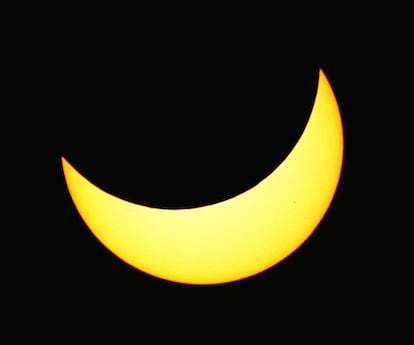How much of Friday’s eclipse will be visible from Spain?
Northern part of the peninsula will see the moon cover as much as 76 percent of the sun

On Friday, shortly after 9am in the Iberian peninsula —and weather permitting— the skies will host a first-rate show that will be visible from all parts of Europe.
The new moon will cross in front of the sun, slowly hiding its disc to create a total solar eclipse for nearly three minutes.
While the best views will be from the Feroe Islands and Svalbard in the northern Atlantic Ocean, millions of people will see a partial eclipse in Europe, North Africa, northwest Asia and the Middle East (in the Americas, only the tip of Newfoundland in Canada will get a glimpse).
Europeans will not get another chance to see an eclipse of the sun again until 2026.
The Madrid Planetarium is organizing a viewing event for interested residents
The total eclipse, which will begin in Greenland and end close to the North Pole, nearly coincides with the March 20 equinox that marks the beginning of spring in the northern hemisphere, resulting in “a high probability of aurora borealis formations,” said Miquel Serra-Ricart, a researcher at the Canary Islands Astrophysics Institute and a veteran eclipse “hunter.”
A solar eclipse occurs when the moon crosses between the sun and the Earth, projecting a shadow on a portion of our planet. Although the moon is much smaller than the sun, it is also a lot closer to us, so that they appear to be the same size when viewed from the Earth’s surface.
In the Iberian peninsula, the best views will be in the north: in the Gacilian city of A Coruña, 76 percent of the sun will be covered by the moon, while in Madrid it will be 67 percent and 64 percent in Barcelona, says the National Museum of Science and Technology.
By comparison, people in London will see 87 percent of the sun in darkness, while in Scotland and northern Sweden, Norway and Finland 97 percent will be covered.
In Madrid, the Planetarium is organizing a viewing event for interested residents. While the eclipse will start to be visible at 9.04am, when the moon begins to advance from the upper right-hand edge of the sun, the eclipse will climax at 10.08am.
Experts warn about the risk of watching an eclipse, either partial or total, without proper eye protection. They also note that popular homemade solutions, such as CDs or film, do not work and put people at risk of serious eye damage.
Adverse weather conditions this week mean that clouds could hinder direct views of the eclipse. Some early planners have already bought airplane tickets to beat the rainy conditions and view the solar eclipse from above the clouds.
Tu suscripción se está usando en otro dispositivo
¿Quieres añadir otro usuario a tu suscripción?
Si continúas leyendo en este dispositivo, no se podrá leer en el otro.
FlechaTu suscripción se está usando en otro dispositivo y solo puedes acceder a EL PAÍS desde un dispositivo a la vez.
Si quieres compartir tu cuenta, cambia tu suscripción a la modalidad Premium, así podrás añadir otro usuario. Cada uno accederá con su propia cuenta de email, lo que os permitirá personalizar vuestra experiencia en EL PAÍS.
¿Tienes una suscripción de empresa? Accede aquí para contratar más cuentas.
En el caso de no saber quién está usando tu cuenta, te recomendamos cambiar tu contraseña aquí.
Si decides continuar compartiendo tu cuenta, este mensaje se mostrará en tu dispositivo y en el de la otra persona que está usando tu cuenta de forma indefinida, afectando a tu experiencia de lectura. Puedes consultar aquí los términos y condiciones de la suscripción digital.
Últimas noticias
The complicated life of Francesca Albanese: A rising figure in Italy but barred from every bank by Trump’s sanctions
Half of Scotland is in the hands of 420 property owners
Pinochet’s victims grapple with José Antonio Kast’s rise in Chile
Reinhard Genzel, Nobel laureate in physics: ‘One-minute videos will never give you the truth’
Most viewed
- Pablo Escobar’s hippos: A serious environmental problem, 40 years on
- Why we lost the habit of sleeping in two segments and how that changed our sense of time
- Charles Dubouloz, mountaineering star, retires at 36 with a farewell tour inspired by Walter Bonatti
- Reinhard Genzel, Nobel laureate in physics: ‘One-minute videos will never give you the truth’
- The Florida Keys tourist paradise is besieged by immigration agents: ‘We’ve never seen anything like this’








































